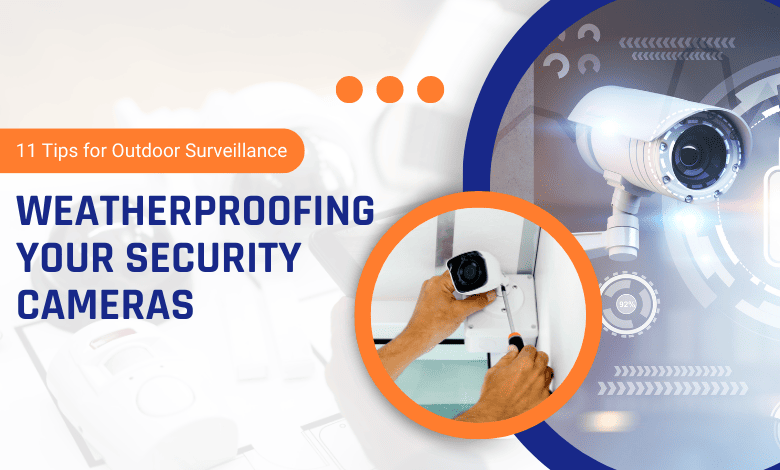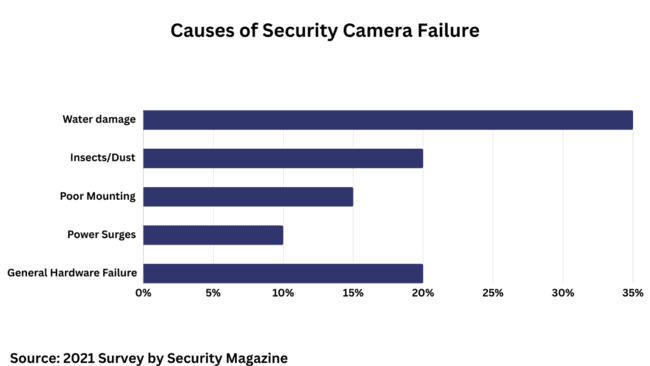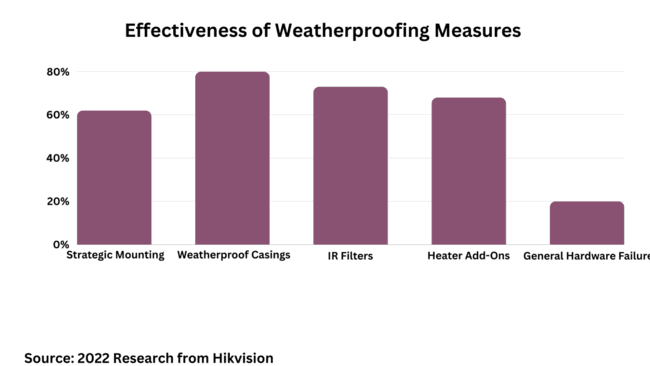Weatherproofing Your Security Cameras: 11 Tips for Outdoor Surveillance

Protecting your outdoor surveillance system from the elements is crucial. Whether it’s deterring thieves or handling harsh weather conditions, you need to ensure your security cameras are up to the task. In this article, we will discuss eleven proven methods for weatherproofing security cameras. Get ready to face the challenges posed by Mother Nature head-on!
1. Combating Outdoor Security Camera Theft
Mike Adams, the founder of Surveillance Defenders, asserts, “Outdoor security camera theft stands no chance against the latest weatherproof CCTV technology.”
To outsmart thieves, position your outdoor cameras strategically, out of their easy reach. Mount them on soffits or high walls using sturdy security mounts. Security camera monitoring is important as you mount them. Opt for dome cameras with tough, vandal-proof metal housings to make life harder for criminals. And for added security, stash your recording equipment in inconspicuous indoor locations.”
Studies reveal that properties equipped with surveillance cameras can deter as much as 67% of attempted break-ins. However, only 3% of crimes in the UK are ever solved using CCTV footage, highlighting the importance of prevention.
2. Defying Dust, Spiders and Bugs
Spiders, bugs and dust accumulating on camera lenses can ruin video surveillance system footage. Security consultant Stan Walczak suggests handy deterrents like infrared filters and camouflaged housings to avoid constant cleaning of lenses.
“Insects find IR night vision lights irresistible. Walczak explains that tricking them with camouflage skins, and clever hiding places is key. It helps avoid constantly cleaning lenses, or replacing units.
The increasing demand from consumers for weatherproof cameras equipped with dust and bug defense is flooding the global market with a variety of options.
3. Safeguarding from Rain Damage
“South Florida’s tropical storms cause chaos.”Thanks to smart strategies like weatherproof casings and careful placement under shade, we’re able to keep surveillance systems running,” Angela Lanes, a surveillance installer from West Palm Beach, explains.
Lanes also explains, “We use heavy-duty, weatherproof enclosures to protect cameras, wires, and junction boxes. These enclosures are IP66 or IP67 rated to prevent damage. A tip: mount cameras above 10 feet in sheltered spots like porches to avoid water damage. And for wiring, bury them in underground PVC conduits to keep them dry,”
Reports show that security camera monitoring in the global video surveillance industry is growing rapidly, at a rate of 16.8% annually. The industry is constantly adopting new technologies like night vision and facial recognition. Waterproofing is crucial for ensuring the reliability of these systems worldwide.
4. Clearing Blurred Vision from Fog
Weather conditions like fog and humidity can seriously affect the clarity of CCTV footage. British security consultant Frank Norton explains, “We can’t get rid of bad weather completely. But, using vented housings, anti-fog treatments, and built-in heaters really helps cameras work better in the cold and wet. Placing outdoor cameras strategically. Using these hardware enhancements can help reduce risks to the environment.
Vented weatherproof casings allow moisture to escape, preventing condensation buildup inside the cameras.
Anti-fog treatments on the glass help water spread out better and let more light through. Built-in heaters stop fogging up inside. Studies show that surveillance systems working well can cut local drug crimes by 20% and property crime by 14% across the country.
5. Preventing Nature’s Wrath – Lightning Strikes
Lightning is a big problem for electronic security systems. Pete Ferguson is a seasoned alarm system installer in Houston. He emphasizes the importance of safeguarding against extreme weather and lightning strikes.
Ferguson suggests installing commercial-grade surge protectors, and lightning arrestors, and ensuring proper system grounding. Additionally, he recommends having separate power backup units to maintain coverage during storms.
Over 6 million property crimes occur nationally each year. Lightning strikes and power outages create prime opportunities for theft. To counter this, robust surveillance devices are equipped with surge protectors. They also have UPS systems and lightning rods. These systems ensure continuous vigilance regardless of external conditions.
6. Preventing Camera Hacking
Remote mobile access makes internet-enabled CCTV cameras susceptible to hacking. Timothy Perez is an ethical hacker collaborating with US law enforcement. He advises, “Keep your firmware updated.” Replace default passwords with strong, 20-character randomized ones. Control wireless access with VPNs, firewalls, and MAC address filtering for wifi devices.”
“Isolate security camera networks using VLANs to constrain breaches only to that domain in case of a rare attack. Perez cautions that online thieves actively target lax home CCTV systems. They gather family data or resell recording access.”. Staying continually alert trumps regretting laxity later. This is one of the very important outdoor surveillance tips for protecting CCTV cameras
7. Troubleshooting Blurry CCTV Footage
“Taking proactive steps can solve more than 90% of issues with fuzzy surveillance footage,” says Michael Safai. He is a CCTV technician from Denmark. He suggests checking lenses regularly for dirt, debris, or spiderwebs and cleaning them with a microfiber cloth and brush. Also, adjusting manual focus, exposure, and IR brightness controls can make a big difference.
“It’s important to inspect cabling to ensure tight, moisture-sealed connections,” Safai emphasizes. Additionally, he advises presetting your camera’s field of view to accurately cover relevant areas. Confirm that the network video recorder has enough storage capacity.
“Lastly,” Safai adds, “consider upgrading to today’s ultra HD 5MP options if you’re still using extremely old CCTV models. This can greatly improve clarity.” Following these simple guidelines ensures high-quality video monitoring.
8. Shielding Cameras from Extreme Heat
High temperatures can be just as damaging to outdoor surveillance equipment as cold and wet conditions. “In regions with scorching summers like Arizona or the Middle East, heat resistance is paramount,” advises Maria Rodriguez. She is a security specialist based in Phoenix. She recommends selecting cameras rated for high temperatures. Also, install them in shaded areas whenever possible.
Utilizing sunshades or protective enclosures can also mitigate heat-related issues. This can prolong the lifespan of your equipment.
9. Winterizing Your Surveillance Setup
Preparing your security cameras for winter is essential, especially in colder climates. “Snow, ice, and freezing temperatures can wreak havoc on outdoor surveillance systems,” warns James Thompson. He is a security expert from Canada. He suggests using cameras specifically designed to withstand freezing temperatures.
Additionally, he advises regularly checking for ice buildup or snow accumulation on lenses. Proper insulation for cables and power sources can prevent damage from cold weather conditions.
10. Securing Against Wildlife Interference
Wildlife can pose unexpected challenges to outdoor security cameras. Animals might trigger false alarms or even chew on cables. “In rural areas or locations near wooded areas, wildlife interference is a real concern,” notes Sarah Johnson. She is a wildlife conservationist and security consultant.
She recommends installing protective covers for cables and conduits. This will deter animals from tampering with them. Motion-activated deterrent devices can also help. They can deter wildlife from approaching the cameras and ensure uninterrupted surveillance.
11. Regular Maintenance and Inspection
Finally, maintain your outdoor surveillance system through regular inspection and maintenance. This is crucial for long-term reliability. “Don’t wait for problems to arise before checking your cameras,” advises David Chen. He has over a decade of experience as a security technician. He recommends scheduling routine inspections to check for signs of wear and tear, loose connections, or water damage.
Regularly cleaning camera lenses and housings can prevent issues such as obscured or blurry footage. Proactive maintenance will help your outdoor security cameras remain effective and reliable. They will stay that way throughout their lifespan.
Conclusion
In conclusion, follow these proven outdoor surveillance camera defense tactics. You can eliminate environmental threats and ensure the security of your property even in tough conditions. Protect against theft, pests, weather, and hacking. Take proactive steps to weatherproof your CCTV system this season. Stay vigilant and keep your property safe!
FAQs
1. What are the security camera theft prevention strategies?
Strategically installing weatherproof CCTV cameras out of arm’s reach deters potential theft. You can use tamper-proof brackets and mounts for this. Vandal-proof metal housings protect devices well. Concealing recorders in homes adds another layer of security.
2. How do I stop insects and spiders from swarming my outdoor CCTV cameras?
Special skins are used to camouflage housing covers in black or dark colors. They also use infrared light filters. Even creative housings, like birdhouses, are used to prevent insects from swarming cameras. They are attracted by bright lights. Frequent lens cleaning also averts problems.
3. What’s the best approach for safeguarding outdoor security cameras from heavy rain?
Marine-grade weatherproof IP66/IP67-rated enclosures shield the entire camera from water damage. They work during storms when positioned correctly overhead under shade. Waterproof cabling further prevents internal shorts through watertight conduits.
Explore further and check out!








